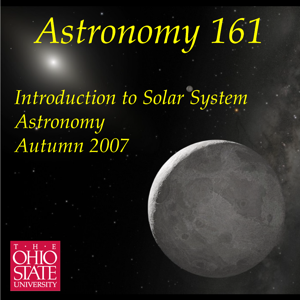Saturn is attended by a system of 60 known moons and bright, beautiful
rings. Today we will explore the moons of Saturn. Among the highlights
are Saturn's lone giant moon, Titan, the 2nd largest moon in the Solar
System and the only one with a heavy atmosphere. The atmosphere of
Titan is mostly nitrogen with a little methane, but the temperature and
pressure are such that methane plays the same role on Titan that water
plays on the Earth: it can be either a solid, gas, or liquid. The
Cassini and Huygens probes have recently shown that there is evidence of
liquid methane flows and mudflats, and even liquid methane lakes as big
as the Great Lakes or Caspian seas on Earth. The other moon of interest
is Enceladus. The shiniest object in the Solar System, Enceladus has
spectacular fountains - cryovolcanos - that spew water vapor from
reservoirs created in its tidally-heated interior. This ice repaves
much of the surface of Enceladus, giving it a young, shiny surface, and
builds the E ring of Saturn. Recorded 2007 Nov 20 in 1000 McPherson Lab
on the Columbus campus of The Ohio State University.
























